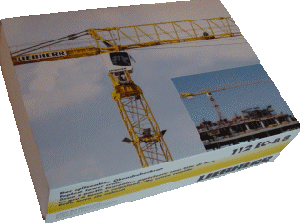 |
| Liebherr picture
sleeve. |
 |
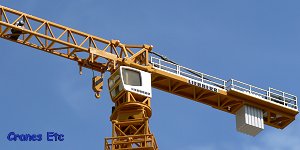 |
| Good lattice work
on the underside of the counter jib. |
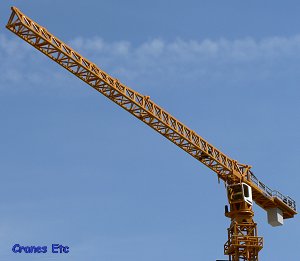 |
| Jib manufacture
is very good. Fully triangulated and dead straight.
|
|
This is a scale model of another variant
of the Liebherr tower crane fleet. This is the 'topless'
version which has become more popular as more cranes are
added to construction sites. The absence of a tower
above the cab for guying the jib and counter jib (hence
the term 'topless') means that less height is required by
another crane in order to over sail.
Packaging
The model is delivered in the familiar Liebherr style with
a picture sleeve enclosing the expanded polystyrene trays
holding the model pieces. An instruction sheet is
included which is printed in German, English and French.
The instructions are generally clear and should present
little problem, even to a novice.
There are however some small errors of detail in the instructions.
They assume that the cab section and short tower above are
one piece when in fact they are supplied as separate pieces.
No mention is made of fitting the trolley motor to the jib
although the photos indicate where to do this. Also
it is assumed that the hoist rope is supplied separate to
the model whereas on the review model the hoisting drum
already had the rope on it. These are minor points
however and on the plus side the instructions are explicit
about how the mast sections should be assembled bearing
in mind the need to align the 'K' struts used by the climbing
frame.
The review model was undamaged.
Detail
The base frame and mast sections are the same castings as
used on the other Liebherr tower crane models in the series
with the only difference being the base frame is painted
grey.
The base section is fitted with plastic bogies and has upstanding
pins on to which the four base ballast blocks fit.
These blocks are an improvement on previous models in that
they are grooved to represent separate slabs of concrete.
The weight of this base arrangement steadies the whole model.
The mast sections join together by pushing together the
sections which have tiny pins included. This system
works well but it can be difficult to join the sections
if they are not lined up properly. Mast detail is
good although one section of the model actually comprises
four sections of the real mast. When joining the mast
sections the orientation is important for realism as the
lattice work differs on the various sides. The side
with the sideways 'K' struts should be on the side of the
hydraulic ram of the climbing frame. Unfortunately
this latest version still does not include mast ladders
as in some other tower crane models of this scale.
A capacity board clips on to the bottom of the mast.
The climbing frame is permanently attached to the cab section.
Although the climbing frame looks alright the walkways do
not seem quite wide enough and the table for sliding in
the mast section looks too high up the frame such that a
scale mast section could not be slid in.
The cab is a big improvement on previous models with the
internal structure of the tower now modelled and visible,
and the cab side window is of the current Liebherr design.
Also the slewing motor is now metal instead of plastic.
The short tower section on top of the cab is a very good
casting and contains two small pulleys to run the hoist
line.
The counter-jib is excellent with a lattice frame on the
underside and very good handrails. The hoist drum
is fitted into a casting which also has an electric equipment
cabinet. Operation of the hoist is by turning the
drum with a finger - there is no unsightly winding handle
to spoil the look of the model. The counterweight
is a single piece which is detailed to look like a number
of separate slabs of concrete and is highly effective.
Support for the counter-jib is provided by two metal guy
rods and these are a big improvement on the wires provided
on earlier models.
The main jib sets this model apart from other tower crane
models. Provided in two pieces, this is the first
tower crane jib which has a fully triangulated lattice rather
than the two sides and open bottom of earlier models and
represents a step change forwards in terms of casting.
It is also made to exacting tolerances as the jib is very
straight when assembled and held together with the plastic
pins provided. A metal trolley motor is also provided
which clips onto the jib. The trolley is the same
plastic type as supplied with Conrad model 2020 and it is
a pity a metal version was not developed. The hook
is a vast improvement over the previous versions and looks
realistic.
Features
The crane rotates smoothly and the trolley can be positioned
at any point along the jib. Raising and lowering the
hook can be simulated. It is possible to display the model
in a few different ways. Three different heights are
possible by using the mast sections provided. The
jib can also be erected using only one jib section and is
a passable representation of a short jib crane.
Quality
The castings are very good and the fully triangulated jib
section is very impressive. The handrails impress
and the use of metal in the counter jib guys gives a quality
feel. Paintwork and lettering are also good.
Price
This model is good value bearing in mind the improvements
that have been made over previous trolley jib tower crane
models.
Overall
This is very good tower crane model and the various improvements
made compared to previous models means that at the time
of the review this is the best trolley jib version available.
Footnotes
The model was introduced in early 2004 in time for the
BAUMA exhibition.
|
|
|
|
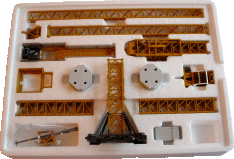 |
| Model is well packed
in the tray. |
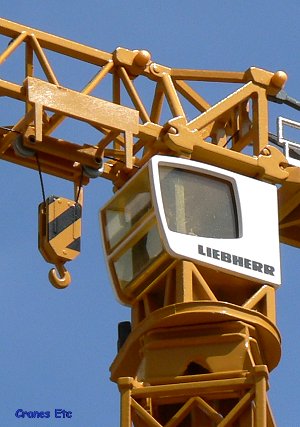 |
| New style cab has
the internal mast structure modelled inside. The metal hook
is a big improvement. |
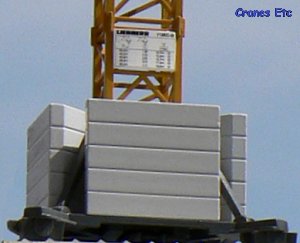 |
| 'Concrete' blocks
at the base and a rating board which clips to the mast.
|
|

